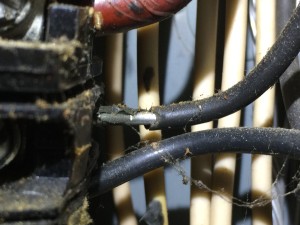Chances are you’ve heard about the dangers of Aluminum Wiring. What most folks don’t know is that not all AL wiring in your home is dangerous. The type of aluminum wiring that poses danger is Small Branch Aluminum Wiring. So what is Small Branch Aluminum Wiring? In this article I’ll tell you about it and explain 5 traits of Small Branch Aluminum Wiring that make it dangerous.
Between 1964-1973 aluminum wires were sometimes used on branch circuits in residential construction. It didn’t take long to figure out that AL wiring, when used on small branch circuits, showed traits that were inferior to its copper counterpart. Here are two photos I took of Small branch Aluminum wires being used in houses in Charlotte, NC.
Below are 5 traits of Small Branch Aluminum Wiring that makes it dangerous. These are the reasons AL wiring was only used on small branch circuits for 9 years.
Trait 1 – Aluminum is soft.
Because aluminum is much softer than copper, it prevents the wiring from being properly connected to outlets, switches and bus bars. When the set screw of an outlet is tightened, the aluminum wire flattens. This can create loose connections, which can lead to arcing, which in turn leads to fires.
Trait 2 – Oxidation
Another problem with Aluminum is that when it’s exposed to elemental oxygen it oxidizes. The byproduct of oxidized AL is called Aluminum Oxide. As it turns out, Aluminum Oxide deteriorates the connection between the small branch aluminum wiring and the connection of the outlet or bus bar.
Trait 3 – Thermal Expansion/Contraction
All things have thermal movement. As things heat up they naturally expand. The problem with small branch aluminum wiring is that when it heats up, it expands much more than copper wiring. Since the wire is carrying current, it is constantly experiencing thermal expansion/contraction. Over time this loosens the wire’s connection, which again, can create arcing and fires.
Trait 4 – Galvanic Reactions
Have you ever seen a car battery and how corroded the connectors are? This is the result of a galvanic reaction. Anytime you have two dissimilar metals or when you add moisture to the aluminum wiring, a very low-voltage current occurs creating a galvanic reaction. This creates corrosion, which can damage the aluminum wires.
Trait 5 – Vibration
As electrical current moves through electrical wiring it creates vibrations. As it turns out, the vibrations are greater as current moves through aluminum wiring than when it moves through copper wiring. These vibrations can also create loose connections, which can overheat the wire as well as create an arc.
These are the 5 traits of small branch aluminum wiring that make it inferior to copper wiring in branch circuits. If your house was built between 1964-1973 call Howdy Home Inspections today. We are the Charlotte Home Inspectors that folks call most to find out if their house has small branch aluminum wires. Give us a call!
Be Happy and Be Kind
T.J. Thorne






